

PROLOGUE
FINDING YOUR WAY

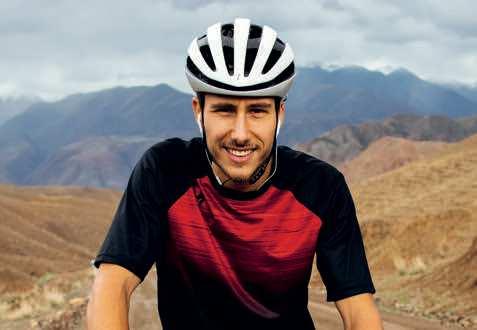
We are Belén and Tristan. Like you, we fostered an interest in what life could be like when pursuing exactly what our hearts desired. For us, this means exploring planet Earth by bicycle with a view to creating meaningful visual content that in turn inspires other people to ride bikes. A fairly simple and straightforward goal that has transformed our lives in a myriad of ways. Mainly because the bicycle has taught us the value of maintaining a healthy state of mind, the importance of protecting the natural environment we breathe and rely on, and introduced us to a worldwide community over owing with strong intentions for the greater good. A community of people from very di erent backgrounds and countries, riding very di erent kinds of bicycles, and all with very di erent reasons for doing so. And yet, we’ve never felt a sense of belonging like we do with this congruent group of human beings.
is led us to creating 50 Ways to Cycle the World, a collection of y unique cycling projects, made by cyclists, for everyone else. To push, inspire, ignite and perceive—to show you how you can nd your own way to cycle the world.
WHY WE MADE THIS BOOK
When we set out to create Bike Life—the book that encapsulates our own story of traveling the world by bicycle—we quickly realized that while it serves as a very personal, detailed and thoughtfully cra ed visual guide on bicycle travel, it might not convince each and every person who reads it to give up their daily dealings with life and trade them for a saddle. Someone who owns a dog might say: “that’s all well and good, but I have a dog to take care of, and I certainly can’t bring this dog along with me”. Another person might argue that they can’t take enough time o work, and that even if they could, they wouldn’t have enough money for a trip like that. Or perhaps you don’t have any nancial concerns, but you don’t have a partner who shares your desire to feel ‘stoked’. And to a person who has never even cycled before, the sheer act of riding up the nearest hill may seem like an unbeatable challenge.
50 Ways to Cycle the World is here to familiarize you with the lives of some eighty wandering souls who have explored the world by bicycle using a plethora of approaches. e pages you’re about to read and the photos you’ll nd throughout this book will convince you that even you, in your unique situation, also have a chance at seeing the world from two wheels.
And that someone else like you, out there, is here to show the way.
WHEN THE WORLD HIT THE BRAKES
But how did this vast collection of cyclists’ stories come about? We have one very simple explanation. When COVID-19 shook the world awake and forced traveling cyclists all over our planet to suddenly stop riding, and in some cases take the rst plane home, all of them were temporarily o the saddle. A rare and precious moment that would most likely have never happened if it wasn’t for the pandemic. A er all, some cyclists were lost in the Chinese, Ethiopian and Kyrgyz steppes without access to the internet for another couple of months. A few others were wandering the Peruvian Andes, Scottish highlands and Patagonian parks without hard drives or le-sharing apps at hand, while the rest were simply too submerged in the experiences a bicycle can ignite. In a perfectly normal world, this idea of ours would’ve stayed on the shelf.
So when we realized it was now or never, we started de ning a massive list of cyclists from those we knew, had heard of or were introduced to—by an all-too persistent social media algorithm that noticed our interest in traveling cyclists had suddenly spiked. We trimmed down the list in such a way that every single project we’d be covering added a splash of diversity, whether it’d be the choice of companionship, the bike they chose to ride, the length of their journey, or its deeper meaning— including as many faces, deep storylines and nationalities as possible to make sure that you have at your disposal a mere y examples of how you can undertake a bicycle tour, just like anybody else. We then set up calls. Before we knew it, we were on video calls three times a day, listening to the mesmerizing and awe-inspiring stories these couples, lone wolves, mothers, fathers, friends and brothers had experienced on their trusty bicycles. It’s a time we’ve come to remember very fondly. And the results of it… are here for you to read. Due to the overwhelming amount of information and the simple limitation of physical pages, we’ve compiled each chapter into an introductory story and a list of unique questions, as well as a single one that is always the same, yet brings a distinct answer with a uni ed undertone every time. And along with it, comes the spectacular visual work these cyclists, or their riding partners, have captured.
And for now, that’s it from us. We leave the stage to those who trusted us in making this book, and hope you will enjoy getting to know them and their respective pursuits as much as we did in the past year.
Happy trails. Belén & Tristan
COMPANIONSHIP
“We live in a time where human relations take place via a screen. People’s words and authenticity are being lost. We are less and less connected with our feelings and with nature. Having to spend so many hours of pedaling shoulder to shoulder allowed me to see how happy my son was to be heard, watched and loved.”
~ TANIA HOPE ~
One might argue that happiness is only real when shared. e cyclists of this chapter all seem to agree with this notion, and recommend it in one way or another. We’d like to start with this particular chapter, as its topic is the backbone of everything that traveling by bicycle encompasses. e social experience that a journey by bicycle brings is an undeniable and essential element, for it happens everywhere, whether when cycling alone or when accompanied. However, as you will read in this chapter, experiences can di er tremendously depending on who accompanies who, and where one is pedaling. Whereas a lone cyclist shares an encounter with local villagers and
might be o ered a stay because of the curiosity they have for her bicycle, a couple decides to cycle on, camping out together in a nearby forest to have some privacy. A family cycling around has a di erent experience due to their children socializing with other kids in town. And of course, nding someone to share your ride with can be a challenge in itself when nobody in the circles of your family or friends cares to join you. It is now time for you to discover the ups and downs of all kinds of approaches to companionship on a bicycle tour, and to nd out how remarkable the mental bene ts of traveling by bicycle really are.
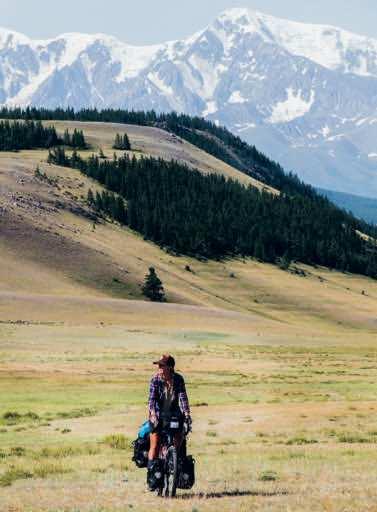
AS A FEMALE
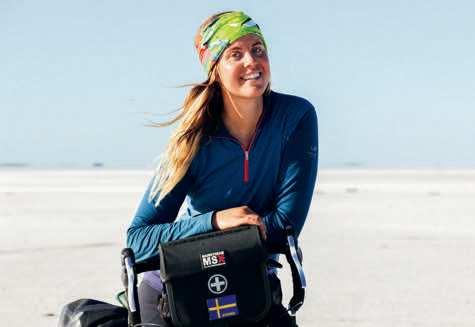
Ann Johansson Sweden (1985) graphic designer, running coach
My Tours: Sweden to Tajikistan (6 months) Sweden to New Zealand (18 months)
MY STORY
Half a year before I turned thirty, I felt that I wanted more out of life than the nine-to- ve routine I was living. I wanted something di erent, something new. So I decided to bring to life a dream I’d had for a while.
Challenges, especially physical, have engaged me since I was a kid. Growing up as the middle child out of ve in a very small village in Sweden, my biggest love was running. It started when I was ve and ran my rst mile on a track. As a teenager I became one of the best middle-distance runners in Sweden and a er high school I got a scholarship to compete for a
university in the USA. Since running had always been such a huge part of my life, it wasn’t until my early twenties that I actually took the time to try other outdoor activities.
It was also in my early twenties that I decided to study graphic design. A er receiving a bachelor degree in 2010, I went on to expand my CV, working for some of the best agencies in Stockholm. But the industry wasn’t like I expected it to be and my creativity was soon replaced by anxiety. at was the start of a life-changing decision: to quit my nine-to- ve life and follow my dream, exploring the world by bicycle.
What encourages you to travel by bike?
For me, traveling by bike is all about feeling connected: to places, to people and to nature. And there are many reasons for this. When the daily speed is no faster than 5-20 km/h, none of the changes in the surroundings go unnoticed. No matter if it is the big things like culture, or the smallest things like the color of the soil beneath you, you see it. You have time to adapt and get used to everything, and suddenly you nd yourself in a country far, far from home and still it doesn’t feel strange or unfamiliar. You feel part of it.
e same happens with the people you meet along the way. Times when I got invited to someone’s home for a meal always made me feel part of their life, if only for a few hours. Of course, traveling in such a rudimentary way also has the e ect of emphasizing the little luxuries that we usually take for granted. A hot shower a er weeks of riding in negative temperatures can suddenly feel like the best thing you have ever experienced. And that is very ful lling.
How did your project take shape? What were you looking to get out of an experience like this?
It actually started back in 2012. A er quitting my job as an art director, I ew to New Zealand to backpack. I soon realized that sitting on a bus between hostels wasn’t for me though. So, with no previous experience, I rented a bicycle, strapped my backpack to the rack and rode around NZ’s South Island with a growing feeling that every day could be a new adventure. ose two months on the saddle felt like two years’ worth of experiences back home—if not more—and I loved every part of it. Even before returning the bike, I knew it. I was hooked.
But life happened, as one says, and it took me until fall of 2014 before I seriously started to plan my next tour. A er setting a date six months ahead of time, I spent my evenings deciding on routes, researching visas, getting my vaccination shots and guessing what on earth I would need to bring with me in the panniers. With only my savings, I le my home in Växjö on the rst of April 2015 and started pedaling south.
e green steppe close to Bayankhongor, Central Mongolia.

Did you want to travel alone right from the start? If so, was there any special reason or goal connected to this choice?
ere were a lot of reasons I decided to go solo. To begin with, I didn’t know anyone who could or even wanted to go with me at the time. Secondly, I’ve always enjoyed being alone, which probably has a lot to do with the fact that I’m an introvert. Reaching out to strangers doesn’t come naturally to me, even if I wish it would. erefore, I saw this tour as a great opportunity to push myself out of my comfort zone and ght my shyness.
In the end, I spent almost 1/4 of the tour accompanied, and I could clearly feel the di erence from when I was solo. Not only in the way I interacted with people, but also vice-versa. When I was solo, more people reached out to me, and I to them. And wherever in the world I was, I felt really cared for by the locals. at feeling was unfortunately a bit lost when I had company.
In which countries did you feel the gender barrier / restrictions the strongest? What did you do to adapt?
It’s ironic that two of my favorite countries on the tour, Turkey and Iran, were also the ones I found the most challenging as a solo female traveler. O the bike, while hosted in someone’s home for example, there were never any problems. Quite the opposite. I was completely overwhelmed by the kindness and generosity of the Turkish and Iranian people. Indeed, the harassments only took place on the road, while cycling.
I was occasionally followed by men on mopeds, whose attempts at getting my attention only got me irritable. e more they tried, the angrier I got, and usually, showing anger was enough to be le alone. But some were more persistent, and I’ve been grabbed to the point that I almost fell o my bike. In those situations, I’d either stopped a passing car for help, or used a trick I read in Juliana Buhring’s book: ‘ is road I ride’. Once, she got cornered by a group of threatening men and started acting crazy; screaming and waving her arms in the air. Turns out that trick also worked for me.
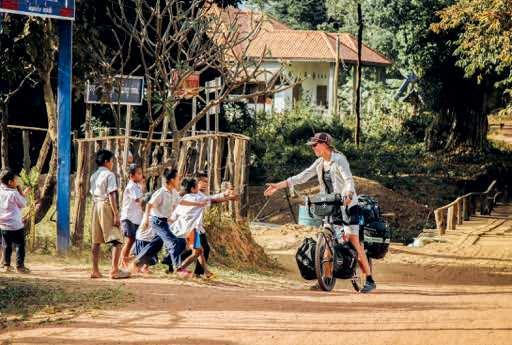
Meeting school kids in a village along the Mekong river, South Laos.
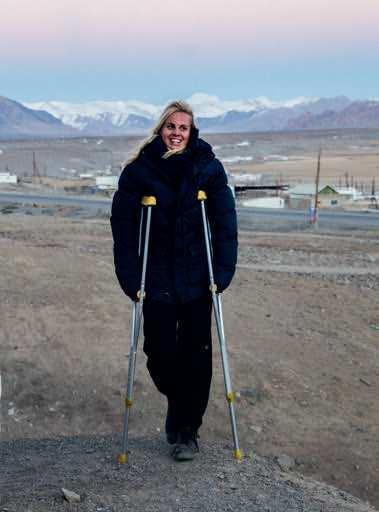
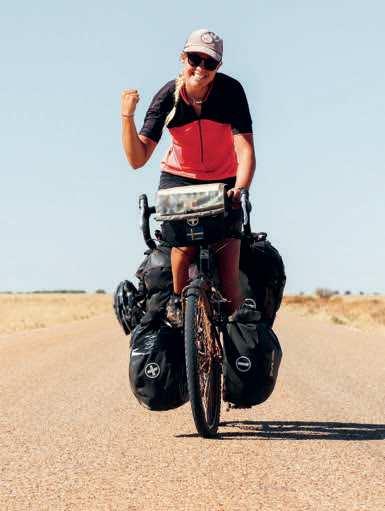
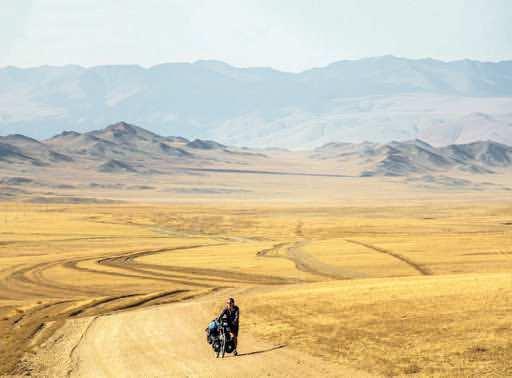
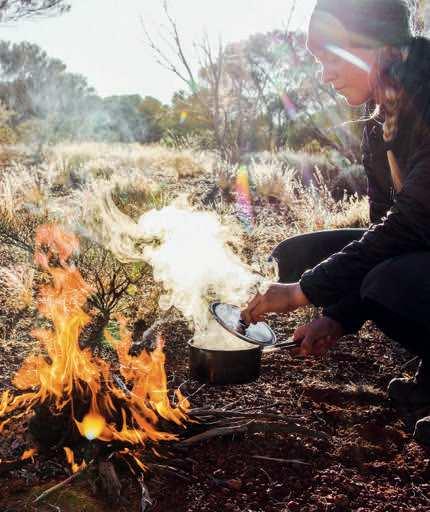
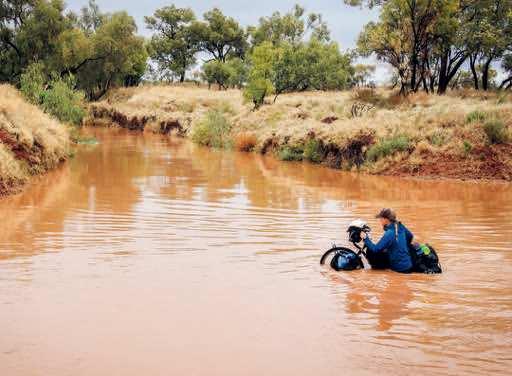
You had a serious accident in Tajikistan and were forced to return home. What happened? And what made you re-start the trip from Sweden again and not from Tajikistan?
In October 2015, I reached the mountains of Tajikistan and together with a cyclist from Finland (Taneli Roininen), we decided to leave the famous Pamir Highway and head for the remote Shokhdara Valley. Surrounded by snowy peaks and harsh landscapes, the valley took us up to Turumtuikul lake at 4,300 m. It was a magic place, but I was tired and hungry, and in a moment of lost concentration a simple hassock threw my wheel sideways and in the fall my foot got caught in the pedal. I felt the sprain right away, knowing that I wouldn’t be able to continue cycling, or even walking. e problem was that we were far away from the nearest village and our phones showed no signal. So, with the hope of nding help, Taneli set o on his bike, while I stayed in my tent. Fi een hours and a snowstorm later, he came back with two locals and a 4x4 truck. A few days later I was on a ight back to Sweden.
While my foot was healing, I started to plan my comeback to the road. My idea was to y to Tajikistan and make my way back to the exact place where I rst fell, and from there, continue on my original route. But the more I thought about it, the stranger it felt to get on a plane to continue my tour. So instead, I decided to start from scratch, from my mom’s front door. My new route included countries like Russia (and Siberia), Kazakhstan and Mongolia, part of the world that felt like a blank sheet of paper with so much to explore.
I don’t really know why, but I also had this obsession to cycle every single meter of my route. Due to sickness and visa limits, that hadn’t happened on my rst “attempt”. Now though, I had another chance to make that reality.
What was the happiest moment on the road for you?
It’s very hard, if not impossible, to pick just one moment that stands out from all the others. ose two years I spent on the road were probably the happiest of my life so far. e combination of exploring the world using my own strength and at the same time meeting so many kind, helpful and inspiring people along the way really was something special. But if I had to mention one thing that always le me as excited as a kid, it was the border crossings. It’s hard to describe the thrill of entering a new country you know so little about. Add on to that the vulnerability of traveling on a bicycle and you have the perfect mix of emotions that can only be described with one word: freedom.
Have you found answers to the questions you had before you le home?
I le home with an endless curiosity about what it’s really like out there. I wanted to know what a family in central Mongolia eats for dinner, what the roads through the desert of Turkmenistan look like and how the capital of Iran sounds from an open apartment window. I wanted to know if I could actually make it. Could I ride my bike from my home all the way to New Zealand? Or was it just a crazy dream? Riding my bike across the world did not only give me answers to all of this, but it got me to realize that there is so much out there that I will never have the time to explore, and there are so many more questions I will never get any answers to. What I really know though is that my journey gave me two major things: a profound belief in myself and my abilities, and a substantial belief in the good in people.
You have become a role model for women around the world. What advice would you give those who’d like to embark on their own adventure, but are uncertain about their safety?
I think that everyone who is about to embark on a big adventure has some kind of fear. But rather than being limited by it, you can choose to face it. Easier said than done, I know. So, what I did prior to my tour was to sort my fears into two categories: the ones that are born out of real danger and the ones that, probably, are just in my head.
For example. Before I le on my tour, one big fear of mine was angry dogs. Reading the many stories where bike tourers have been chased down the road by packs of dogs, it felt like a quite legitimate fear. What helped me with this was research. I read everything I could nd about it, learning how to and how not to act in such a situation; information that actually helped me a lot later on.
Another fear I had before leaving was something as simple as the dark. Just the thought of wild camping alone in the dark gave me chills. And I knew that no research in the world would ease this fear. I just had to face it. In the end I spent hundreds of nights alone in my tent, and I won’t deny that those rst weeks on the tour were tough. But it got better and better, and today it doesn’t bother me at all.
So, if you think it can help, research your fear to mitigate the risks. If not, stop analyzing and just go for it! I promise it will get easier with time.
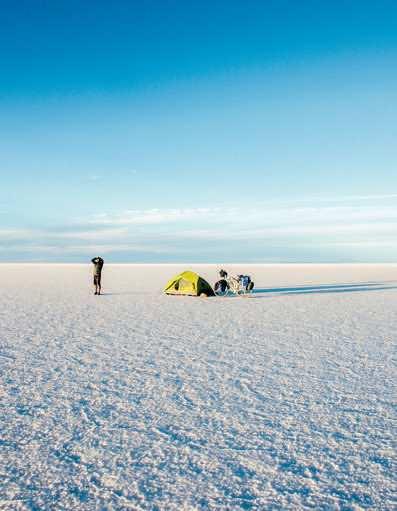
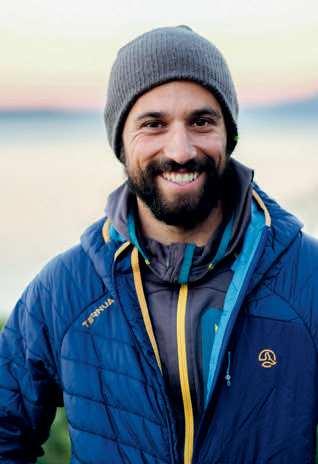
Javier Martínez Spain (1983) photographer
My Tour:
Asia, Europe, Africa, South America (9 years)
MY STORY
I used to work as a photojournalist in di erent con ict areas around the world, but at some point I felt so mentally tired that I decided to quit and return home. Instead, I was to travel the world to share and capture the more optimistic stories of humanity, far from misery and war and spreading a message of hope. Traveling slowly, on a bicycle, seemed the perfect way to stay t, interact with strangers and experience a di erent and happier lifestyle close to nature.
A er a few months of preparation in London (where I used to be based), I boarded a ight to Indonesia where I started cycling solo. Nine years later, a er having pedaled through major parts of Asia, Europe, Africa and South America, and having lived through the craziest adventures, anecdotes and challenges, I never imagined it would be love that would get me to pause my world bike tour. is is not the end of my journey, just a little and desired interruption.
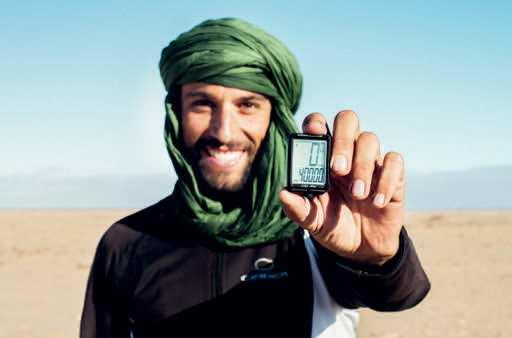
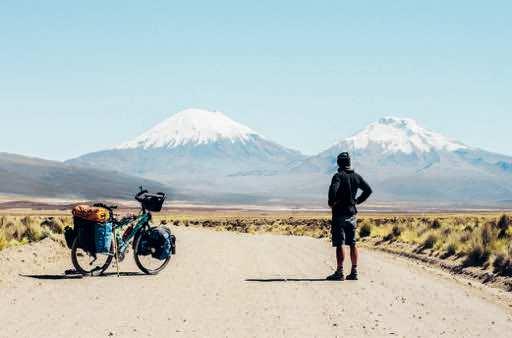
What encourages you to travel by bike?
Traveling by bike gives you the opportunity to see the world at a perfect pace: not too fast, not too slow. And you get to stop in places you otherwise never would. I love that while traveling you are also doing exercise, so your body creates many more endorphins—the hormones of happiness. And lastly but not less important, it’s a cheaper way to move around, giving you the opportunity to travel forever.
My rst trip ever was on a bicycle, back in 2000 when I was 18. I always remembered that feeling of freedom, which is what led me to doing it again.

What do you consider the pros of cycling solo? Would you recommend it to other solo men or women?
Cycling solo gives you the opportunity to face the world in a more open way. e world gets exposed to you and when you meet someone, the connection is much greater. But the best thing is that you get to make the decisions that you want to make with no need for questions or explanations. When traveling as a couple or with others, there are always ups and downs. When you cycle alone, life is more linear.
Taking a break to admire the Parinacota (6,380 m) in Bolivia.
Cycling through the Sahara desert—hitting another milestone!
Camping with a view of Huascarán (6,768 m) in the Cordillera Blanca, Peru. > >
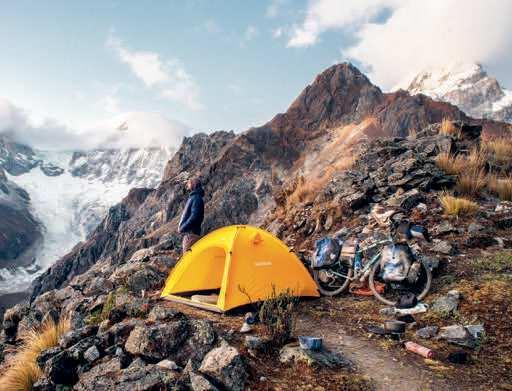
Has there been a country or culture where you felt more welcome and safe just due to being a male? If so, describe which situation(s) made you notice this.
While traveling as a male you are less vulnerable, as unfortunately, we live in a world made for men, ruled by men. When cycling alone, I always felt safe, though I did notice that, when pedaling with my former partner, we were welcomed into locals’ homes more o en. is probably happened because I was with a woman. I can understand some people would feel safer bringing a couple into their home rather than a solo male. is was especially noticeable in Muslim countries.
A bicycle tour can be mentally challenging since you see all kinds of problems around the world. But at the same time, it can also reinstate your faith in humanity. Were you able to maintain a positive mindset on your trip?
Traveling by bike made me more optimistic and faithful towards humanity, experiencing extreme hospitality from the kindest and humblest people willing to help me out. Even locals who owned next to nothing would still try to give me everything they could. Put simply, if humans see the chance to help another human, they will.
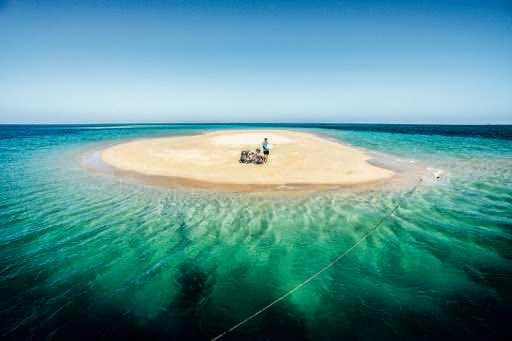
Did you feel lonely at any point of your ride?
How weird would it be if I told you that the only places I ever felt lonely were the places that were actually full of people? And, by contrast, where I felt the least lonely was in inhospitable, wild locations without a single trace of other human beings. Such as deep in the jungle, up on a summit or in the middle of the desert.
Share with us the one meal you consistently cooked on your world tour, and what ingredient always made it that little bit more special.
One of the things I always carry with me on my bike and consider of most importance is olive oil (even better if it comes from Spain). Good olive oil is all I need to make any meal nice: pasta, rice, bread… Also, I always use Moringa: a superfood full of iron, amino-acids and vitamins, and cheap and light to carry.
As a photographer, what was it that you wanted to capture throughout your adventure? Was it very important for you to document your trip as much as possible?
At rst, I wanted to document the lives and issues of all those forgotten individuals. Not in a negative way but instead with a message of hope. I didn’t just want to show the beautiful side of traveling from the comfort of a western tourist, instead trying to portray the complete reality of travel as accurately as I could. Always from my point of view.
e Quirimbas Islands, just o the northern coast of Mozambique.
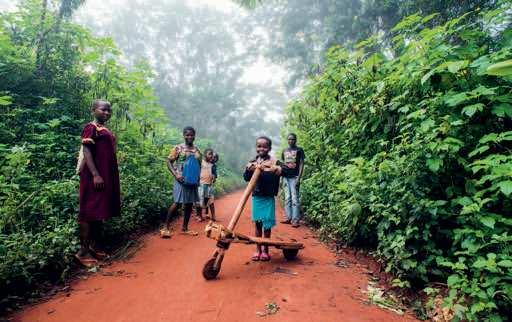
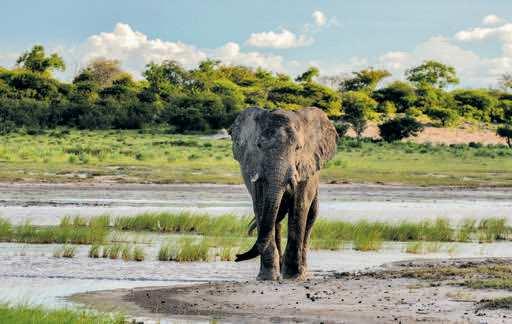
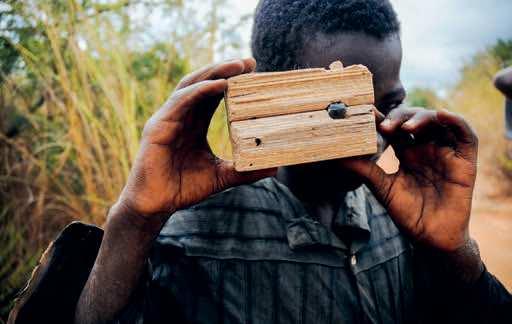

Tell us about some of the more con ict-torn countries you cycled through. How did social unrest and the simple realities of corruption make you feel?
Nigeria tops the list by far. It’s having terrible problems with Boko Haram, an islamist group. People thought I was one of them, a cyclist jihadist. On a few occasions I got attacked by a mob of people thinking I was carrying explosives on my bike and that I ought to be locked up by the police.
You’ve crossed some pretty unforgivable landscapes in tough seasons. What was your motivation for crossing snow, ice, heat and sand when conditions were at their toughest?
e harder the ride, the nicer the destination. Opting for the biggest challenges and e ort always brings the greatest rewards, and they make me feel more alive than ever. at’s the reason I crossed Patagonia and the Pamirs in the winter and the Congo forest in the rainy season.
A er 9 years on the road, having experienced all kinds of unimaginable situations and believing that only health could stop you from completing your world tour, you met someone. Was it easy to shi your focus from your major goal and settle down in Colombia?
At rst, it felt like a very di cult decision to make. I was so obsessed with reaching Alaska, the end of my around-theworld journey, that I completely forgot that the beauty of traveling is not the destination, but the way to the destination. I was lucky to nd on my way the most beautiful thing I could ever imagine. Becoming a father has certainly been the most exciting adventure I’ve experienced so far, and as Alaska isn’t set to move elsewhere, I can wait a couple of years and then cycle there with my new family.
A solo journey by bike is a very intense confrontation with yourself. Who are you today a er all the miles you’ve pedaled? How has the bicycle changed you?
I started cycling when I was 27. It’s di cult to say whether it was the bicycle that changed me or whether it was just life. But seeing cycling as a philosophy, as a way of life, I think the combination of the two has made me the Javier I am today.
